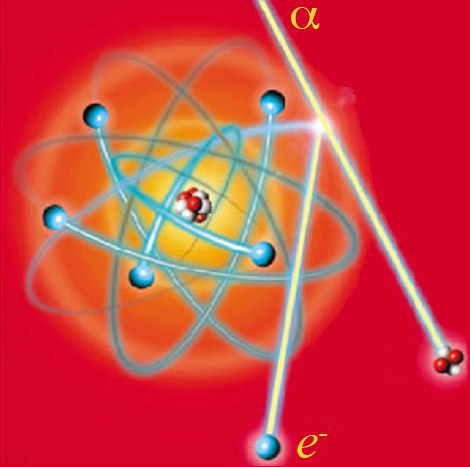WP2 – Optimization of SPT
 WP2 is about improving treatment plans via modeling and computer simulation.
WP2 is about improving treatment plans via modeling and computer simulation.
The partners involved in the WP2 are: LPC Caen, IPHC Strasbourg, LARIA (Caen), the IMNC (Orsay) the CREATIS (Lyon), the U825 (Toulouse) and LPC Clermont-Ferrand.
WP2.1- Measurements of cross-sections and biological data
Cross-sections: 2 series of measurements were recorded at GANIL in 2011. Thin and thick targets of medical interest (H,C,O and Ca) were studied at 95 MeV/u at 0°. The data are being analysed and results will be published in late 2013-2014. This ongoing work will pursue three milestones of which one will be a decision-point:
- 1st milestone: late 2013, the availability of the GANIL room will create access to more useful beam time;
- 2nd milestone: late 2015, a decision will be made as to whether the progress made in the new collision model allows the determination of its credibility: if so, then the model will be used, and there will be a drastic reduction in the scheduling of physical measurements; if not, then increased scheduling of experiments will occur, and depending on whether or not a Hadron Therapy centre will have been built by this time (ETOILE or ARCHADE), the specifications for instrumentation will be adapted (to be assigned to RecHadron) in order to render it mobile or not depending on which sites are available for these measurements;
- 3rd milestone: after 2015, possible implementation in an ARCHADE, ETOILE or other adapted site. This work will be pursued over the long-term.
Biological Data: Photon reference data is being acquired simultaneously in the 3 sites of FrHA;
- 1st milestone: late 2012, setting-up of the EquipEx RecHadron for photon reference measurements;
- 2nd milestone: late 2013, availability of the GANIL room as described above;
- 3rd milestone: late 2014, availability of an experimental proton line allowing one to pursue this work more rapidly. This work will be carried out over the long-term with biological models of increasing complexity. This multicentric work will be coordinated with models, protocols and a common quality monitoring.
WP2.2 and 2.3- Simulation tool and simulation platform for dose deposit and treatment :
The following tasks do not require equipment investments or beam time in the short-term, but are indispensible for carrying out the research program over the longer term. They could be carried out in parallel with experimental measurements.
- 1st milestone: late 2014, evaluation and/or development of nuclear collision models based on existing experimental data (WP2.2);
- 2nd milestone: end 2014, release of a Monte Carlo simulation tool of reference based in Geant4/GATE (WP 2.2 et WP 2.3) partially supported by the IMADRON Physics Cancer project (2012-2013);
- 3rd miles-tone: optimisation of dose calculation algorithms with the aim of integrating them into a TPS (WP 2.3). After 3 years, the performances of the collision models will be known. Two cases could arise as indicated above in WP2.1, 2nd milestone.
The aim is to produce a collision model (to be evaluated at the end of 2015) and a Monte Carlo simulation platform of reference (upgrade of the Geant4/GATE platform already supporting simulations of radiation therapy, PET and single photon imaging http://www.opengatecollaboration.org) (beginning of 2014) including a user-friendly interface so as to be usable by Medical Physicists (end of 2015).
In the longer term (beyond 3 years), this experimental work in the fields of physics and radiobiology will be pursued by centres at which carbon beams of therapeutically interesting energies (from 30 MeV/u to 400 MeV/u) will be available. The reference Monte Carlo tool will be upgraded regularly to include advances in physics models and new experimental cross-sections. Fast simulation tools implemented in TPS will be validated against the Monte Carlo code of reference.
WP2.4- Multimodal functional and metabolic imaging :
The aim is to apply the multimodal integration of functional, metabolic and spectroscopic medical imaging information to hadron therapy in order to optimise the definition of the targets to be treated, to define new targets and to propose clinical research hypotheses. Platforms allowing the exchange, manipulation and storage of data are also examples of platforms required for clinical research. These developments are currently being pursued in the following projects: SUMMER (FP7, 2012-18) which aims to combine and treat several imaging sources including spectroscopic ones; PHRC (the hospital clinical research programme) SpectroGlio (2008-17) as well as the IRON LabEx (2012). This project should also form links with F-CRIN for the exchange of data.
By this way, a new target definition process will be based on PET in 2013; a functional platform for multimodal, medical data integration accessible through a network for FrHA clinical research (2014).
Contact : Daniel Cussol, Caen.
Events
June-5th 2015: WP4 meeting in Lyon
May-11th 2015 : Steering-commitee meeting in Paris
April-15th 2015: WP1 meeting in Orsay
Module-Workshops and international meeting
May 18-23 2015: 54th PTCOG - Manchester Grand Hyatt, San Diego, California







